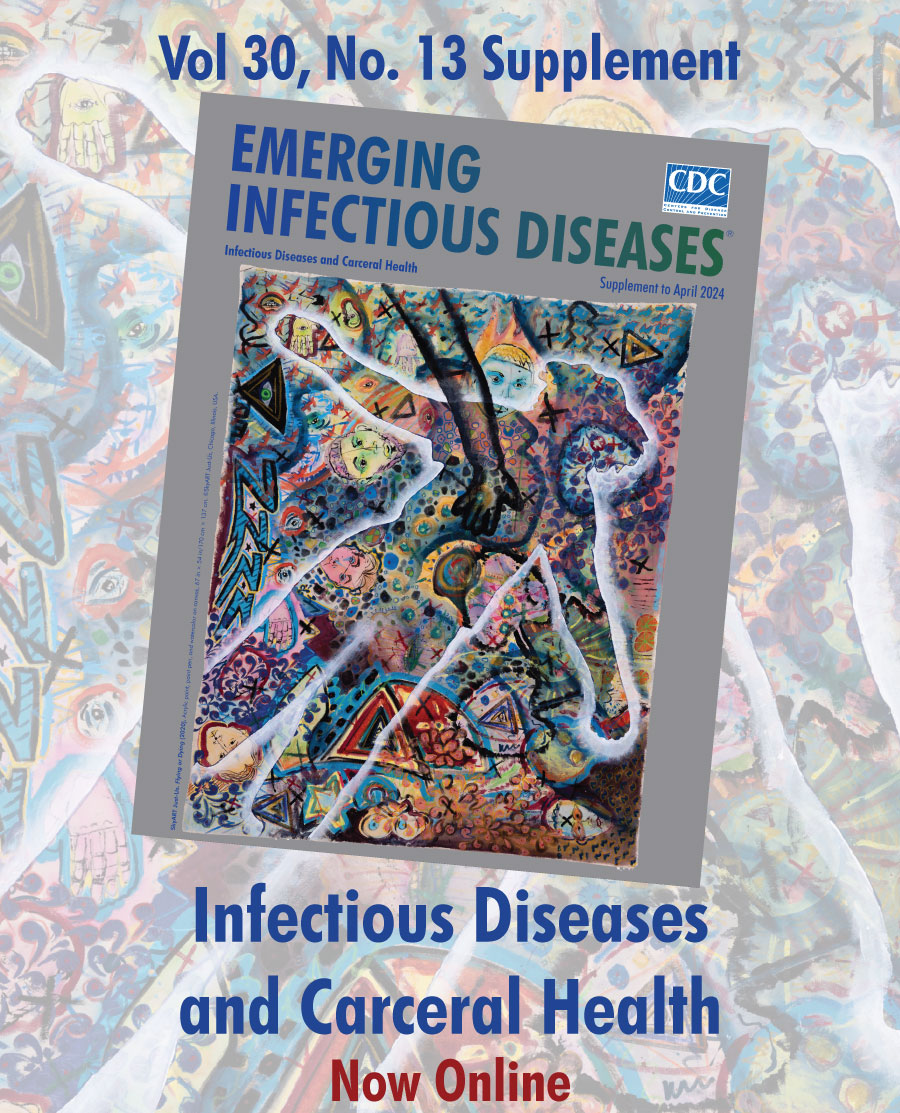Medscape CME Activity
Medscape, LLC is pleased to provide online continuing medical education (CME) for selected journal articles, allowing clinicians the opportunity to earn CME credit. In support of improving patient care, these activities have been planned and implemented by Medscape, LLC and Emerging Infectious Diseases. Medscape, LLC is jointly accredited by the Accreditation Council for Continuing Medical Education (ACCME), the Accreditation Council for Pharmacy Education (ACPE), and the American Nurses Credentialing Center (ANCC), to provide continuing education for the healthcare team.
CME credit is available for one year after publication.
Volume 29—2023
Volume 29, Number 12—December 2023
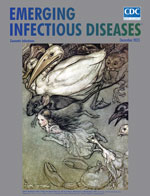
We reviewed invasive Nocardia infections in 3 noncontiguous geographic areas in the United States during 2011–2018. Among 268 patients with invasive nocardiosis, 48.2% were from Minnesota, 32.4% from Arizona, and 19.4% from Florida. Predominant species were N. nova complex in Minnesota (33.4%), N. cyriacigeorgica in Arizona (41.4%), and N. brasiliensis in Florida (17.3%). Transplant recipients accounted for 82/268 (30.6%) patients overall: 14 (10.9%) in Minnesota, 35 (40.2%) in Arizona, and 33 (63.5%) in Florida. Manifestations included isolated pulmonary nocardiosis among 73.2% of transplant and 84.4% of non–transplant patients and central nervous system involvement among 12.2% of transplant and 3.2% of non–transplant patients. N. farcinica (20.7%) and N. cyriacigeorgica (19.5%) were the most common isolates among transplant recipients and N. cyriacigeorgica (38.0%), N. nova complex (23.7%), and N. farcinica (16.1%) among non–transplant patients. Overall antimicrobial susceptibilities were similar across the 3 study sites.
| EID | Gupta S, Grant LM, Powers HR, Kimes KE, Hamdi A, Butterfield RJ, et al. Invasive Nocardia Infections across Distinct Geographic Regions, United States. Emerg Infect Dis. 2023;29(12):2417-2425. https://doi.org/10.3201/eid2912.230673 |
|---|---|
| AMA | Gupta S, Grant LM, Powers HR, et al. Invasive Nocardia Infections across Distinct Geographic Regions, United States. Emerging Infectious Diseases. 2023;29(12):2417-2425. doi:10.3201/eid2912.230673. |
| APA | Gupta, S., Grant, L. M., Powers, H. R., Kimes, K. E., Hamdi, A., Butterfield, R. J....Vikram, H. R. (2023). Invasive Nocardia Infections across Distinct Geographic Regions, United States. Emerging Infectious Diseases, 29(12), 2417-2425. https://doi.org/10.3201/eid2912.230673. |
We collected stool from school-age children from 352 households living in the Black Belt region of Alabama, USA, where sanitation infrastructure is lacking. We used quantitative reverse transcription PCR to measure key pathogens in stool that may be associated with water and sanitation, as an indicator of exposure. We detected genes associated with >1 targets in 26% of specimens, most frequently Clostridioides difficile (6.6%), atypical enteropathogenic Escherichia coli (6.1%), and enteroaggregative E. coli (3.9%). We used generalized estimating equations to assess reported risk factors for detecting >1 pathogen in stool. We found no association between lack of sanitation and pathogen detection (adjusted risk ratio 0.95 [95% CI 0.55–1.7]) compared with specimens from children served by sewerage. However, we did observe an increased risk for pathogen detection among children living in homes with well water (adjusted risk ratio 1.7 [95% CI 1.1–2.5]) over those reporting water utility service.
| EID | Capone D, Bakare T, Barker T, Chatham A, Clark R, Copperthwaite L, et al. Risk Factors for Enteric Pathogen Exposure among Children in Black Belt Region of Alabama, USA. Emerg Infect Dis. 2023;29(12):2434-2442. https://doi.org/10.3201/eid2912.230780 |
|---|---|
| AMA | Capone D, Bakare T, Barker T, et al. Risk Factors for Enteric Pathogen Exposure among Children in Black Belt Region of Alabama, USA. Emerging Infectious Diseases. 2023;29(12):2434-2442. doi:10.3201/eid2912.230780. |
| APA | Capone, D., Bakare, T., Barker, T., Chatham, A., Clark, R., Copperthwaite, L....Brown, J. (2023). Risk Factors for Enteric Pathogen Exposure among Children in Black Belt Region of Alabama, USA. Emerging Infectious Diseases, 29(12), 2434-2442. https://doi.org/10.3201/eid2912.230780. |
Volume 29, Number 11—November 2023
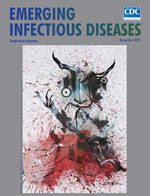
Campylobacter fetus accounts for 1% of Campylobacter spp. infections, but prevalence of bacteremia and risk for death are high. To determine clinical features of C. fetus infections and risks for death, we conducted a retrospective observational study of all adult inpatients with a confirmed C. fetus infection in Nord Franche-Comté Hospital, Trevenans, France, during January 2000–December 2021. Among 991 patients with isolated Campylobacter spp. strains, we identified 39 (4%) with culture-positive C. fetus infections, of which 33 had complete records and underwent further analysis; 21 had documented bacteremia and 12 did not. Secondary localizations were reported for 7 (33%) patients with C. fetus bacteremia, of which 5 exhibited a predilection for vascular infections (including 3 with mycotic aneurysm). Another 7 (33%) patients with C. fetus bacteremia died within 30 days. Significant risk factors associated with death within 30 days were dyspnea, quick sequential organ failure assessment score >2 at admission, and septic shock.
| EID | Zayet S, Klopfenstein T, Gendrin V, Vuillemenot J, Plantin J, Toko L, et al. Campylobacter fetus Invasive Infections and Risks for Death, France, 2000–2021. Emerg Infect Dis. 2023;29(11):2189-2197. https://doi.org/10.3201/eid2911.230598 |
|---|---|
| AMA | Zayet S, Klopfenstein T, Gendrin V, et al. Campylobacter fetus Invasive Infections and Risks for Death, France, 2000–2021. Emerging Infectious Diseases. 2023;29(11):2189-2197. doi:10.3201/eid2911.230598. |
| APA | Zayet, S., Klopfenstein, T., Gendrin, V., Vuillemenot, J., Plantin, J., Toko, L....Royer, P. (2023). Campylobacter fetus Invasive Infections and Risks for Death, France, 2000–2021. Emerging Infectious Diseases, 29(11), 2189-2197. https://doi.org/10.3201/eid2911.230598. |
Group A Streptococcus (GAS) primary peritonitis is a rare cause of pediatric acute abdomen (sudden onset of severe abdominal pain); only 26 pediatric cases have been reported in the English language literature since 1980. We discuss 20 additional cases of pediatric primary peritonitis caused by GAS among patients at Starship Children’s Hospital, Auckland, New Zealand, during 2010–2022. We compare identified cases of GAS primary peritonitis to cases described in the existing pediatric literature. As rates of rates of invasive GAS increase globally, clinicians should be aware of this cause of unexplained pediatric acute abdomen.
| EID | Taylor A, Elliott BM, Atkinson J, Roberts S, Voss L, Best EJ, et al. Group A Streptococcus Primary Peritonitis in Children, New Zealand. Emerg Infect Dis. 2023;29(11):2203-2209. https://doi.org/10.3201/eid2911.230211 |
|---|---|
| AMA | Taylor A, Elliott BM, Atkinson J, et al. Group A Streptococcus Primary Peritonitis in Children, New Zealand. Emerging Infectious Diseases. 2023;29(11):2203-2209. doi:10.3201/eid2911.230211. |
| APA | Taylor, A., Elliott, B. M., Atkinson, J., Roberts, S., Voss, L., Best, E. J....Webb, R. (2023). Group A Streptococcus Primary Peritonitis in Children, New Zealand. Emerging Infectious Diseases, 29(11), 2203-2209. https://doi.org/10.3201/eid2911.230211. |
Volume 29, Number 10—October 2023
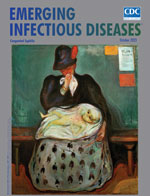
Ongoing surveillance after pneumococcal conjugate vaccination (PCV) deployment is essential to inform policy decisions and monitor serotype replacement. We report serotype and disease severity trends in 3,719 adults hospitalized for pneumococcal disease in Bristol and Bath, United Kingdom, during 2006–2022. Of those cases, 1,686 were invasive pneumococcal disease (IPD); 1,501 (89.0%) had a known serotype. IPD decreased during the early COVID-19 pandemic but during 2022 gradually returned to prepandemic levels. Disease severity changed throughout this period: CURB65 severity scores and inpatient deaths decreased and ICU admissions increased. PCV7 and PCV13 serotype IPD decreased from 2006–2009 to 2021–2022. However, residual PCV13 serotype IPD remained, representing 21.7% of 2021–2022 cases, indicating that major adult PCV serotype disease still occurs despite 17 years of pediatric PCV use. Percentages of serotype 3 and 8 IPD increased, and 19F and 19A reemerged. In 2020–2022, a total of 68.2% IPD cases were potentially covered by PCV20.
| EID | Hyams C, Challen R, Hettle D, Amin-Chowdhury Z, Grimes C, Ruffino G, et al. Serotype Distribution and Disease Severity in Adults Hospitalized with Streptococcus pneumoniae Infection, Bristol and Bath, UK, 2006‒2022. Emerg Infect Dis. 2023;29(10):1953-1964. https://doi.org/10.3201/eid2910.230519 |
|---|---|
| AMA | Hyams C, Challen R, Hettle D, et al. Serotype Distribution and Disease Severity in Adults Hospitalized with Streptococcus pneumoniae Infection, Bristol and Bath, UK, 2006‒2022. Emerging Infectious Diseases. 2023;29(10):1953-1964. doi:10.3201/eid2910.230519. |
| APA | Hyams, C., Challen, R., Hettle, D., Amin-Chowdhury, Z., Grimes, C., Ruffino, G....Finn, A. (2023). Serotype Distribution and Disease Severity in Adults Hospitalized with Streptococcus pneumoniae Infection, Bristol and Bath, UK, 2006‒2022. Emerging Infectious Diseases, 29(10), 1953-1964. https://doi.org/10.3201/eid2910.230519. |
In Mississippi, USA, infant hospitalization with congenital syphilis (CS) spiked by 1,000%, from 10 in 2016 to 110 in 2022. To determine the causes of this alarming development, we analyzed Mississippi hospital discharge data to evaluate trends, demographics, outcomes, and risk factors for infants diagnosed with CS hospitalized during 2016–2022. Of the 367 infants hospitalized with a CS diagnosis, 97.6% were newborn, 92.6% were covered by Medicaid, 71.1% were African American, and 58.0% were nonurban residents. Newborns with CS had higher odds of being affected by maternal illicit drug use, being born prematurely (<37 weeks), and having very low birthweight (<1,500 g) than those without CS. Mean length of hospital stay (14.5 days vs. 3.8 days) and mean charges ($56,802 vs. $13,945) were also higher for infants with CS than for those without. To address escalation of CS, Mississippi should invest in comprehensive prenatal care and early treatment of vulnerable populations.
| EID | Staneva M, Hobbs CV, Dobbs T. Spike in Congenital Syphilis, Mississippi, USA, 2016–2022. Emerg Infect Dis. 2023;29(10):1965-1972. https://doi.org/10.3201/eid2910.230421 |
|---|---|
| AMA | Staneva M, Hobbs CV, Dobbs T. Spike in Congenital Syphilis, Mississippi, USA, 2016–2022. Emerging Infectious Diseases. 2023;29(10):1965-1972. doi:10.3201/eid2910.230421. |
| APA | Staneva, M., Hobbs, C. V., & Dobbs, T. (2023). Spike in Congenital Syphilis, Mississippi, USA, 2016–2022. Emerging Infectious Diseases, 29(10), 1965-1972. https://doi.org/10.3201/eid2910.230421. |
Volume 29, Number 9—September 2023
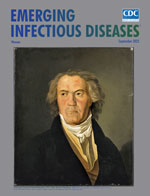
Borrelia miyamotoi, transmitted by Ixodes spp. ticks, was recognized as an agent of hard tick relapsing fever in the United States in 2013. Nine state health departments in the Northeast and Midwest have conducted public health surveillance for this emerging condition by using a shared, working surveillance case definition. During 2013–2019, a total of 300 cases were identified through surveillance; 166 (55%) were classified as confirmed and 134 (45%) as possible. Median age of case-patients was 52 years (range 1–86 years); 52% were male. Most cases (70%) occurred during June–September, with a peak in August. Fever and headache were common symptoms; 28% of case-patients reported recurring fevers, 55% had arthralgia, and 16% had a rash. Thirteen percent of patients were hospitalized, and no deaths were reported. Ongoing surveillance will improve understanding of the incidence and clinical severity of this emerging disease.
| EID | McCormick DW, Brown CM, Bjork J, Cervantes K, Esponda-Morrison B, Garrett J, et al. Characteristics of Hard Tick Relapsing Fever Caused by Borrelia miyamotoi, United States, 2013–2019. Emerg Infect Dis. 2023;29(9):1719-1729. https://doi.org/10.3201/eid2909.221912 |
|---|---|
| AMA | McCormick DW, Brown CM, Bjork J, et al. Characteristics of Hard Tick Relapsing Fever Caused by Borrelia miyamotoi, United States, 2013–2019. Emerging Infectious Diseases. 2023;29(9):1719-1729. doi:10.3201/eid2909.221912. |
| APA | McCormick, D. W., Brown, C. M., Bjork, J., Cervantes, K., Esponda-Morrison, B., Garrett, J....Kugeler, K. J. (2023). Characteristics of Hard Tick Relapsing Fever Caused by Borrelia miyamotoi, United States, 2013–2019. Emerging Infectious Diseases, 29(9), 1719-1729. https://doi.org/10.3201/eid2909.221912. |
During 2006–2021, Canada had 55 laboratory-confirmed outbreaks of foodborne botulism, involving 67 cases. The mean annual incidence was 0.01 case/100,000 population. Foodborne botulism in Indigenous communities accounted for 46% of all cases, which is down from 85% of all cases during 1990–2005. Among all cases, 52% were caused by botulinum neurotoxin type E, but types A (24%), B (16%), F (3%), and AB (1%) also occurred; 3% were caused by undetermined serotypes. Four outbreaks resulted from commercial products, including a 2006 international outbreak caused by carrot juice. Hospital data indicated that 78% of patients were transferred to special care units and 70% required mechanical ventilation; 7 deaths were reported. Botulinum neurotoxin type A was associated with much longer hospital stays and more time spent in special care than types B or E. Foodborne botulism often is misdiagnosed. Increased clinician awareness can improve diagnosis, which can aid epidemiologic investigations and patient treatment.
| EID | Harris RA, Tchao C, Prystajecky N, Weedmark K, Tcholakov Y, Lefebvre M, et al. Foodborne Botulism, Canada, 2006–2021. Emerg Infect Dis. 2023;29(9):1730-1737. https://doi.org/10.3201/eid2909.230409 |
|---|---|
| AMA | Harris RA, Tchao C, Prystajecky N, et al. Foodborne Botulism, Canada, 2006–2021. Emerging Infectious Diseases. 2023;29(9):1730-1737. doi:10.3201/eid2909.230409. |
| APA | Harris, R. A., Tchao, C., Prystajecky, N., Weedmark, K., Tcholakov, Y., Lefebvre, M....Austin, J. W. (2023). Foodborne Botulism, Canada, 2006–2021. Emerging Infectious Diseases, 29(9), 1730-1737. https://doi.org/10.3201/eid2909.230409. |
Volume 29, Number 8—August 2023
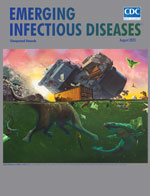
Corynebacterium ulcerans is a closely related bacterium to the diphtheria bacterium C. diphtheriae, and some C. ulcerans strains produce toxins that are similar to diphtheria toxin. C. ulcerans is widely distributed in the environment and is considered one of the most harmful pathogens to livestock and wildlife. Infection with C. ulcerans can cause respiratory or nonrespiratory symptoms in patients. Recently, the microorganism has been increasingly recognized as an emerging zoonotic agent of diphtheria-like illness in Japan. To clarify the overall clinical characteristics, treatment-related factors, and outcomes of C. ulcerans infection, we analyzed 34 cases of C. ulcerans that occurred in Japan during 2001–2020. During 2010–2020, the incidence rate of C. ulcerans infection increased markedly, and the overall mortality rate was 5.9%. It is recommended that adults be vaccinated with diphtheria toxoid vaccine to prevent the spread of this infection.
| EID | Yamamoto A, Hifumi T, Ato M, Iwaki M, Senoh M, Hatanaka A, et al. Clinical Characteristics of Corynebacterium ulcerans Infection, Japan. Emerg Infect Dis. 2023;29(8):1505-1515. https://doi.org/10.3201/eid2908.220058 |
|---|---|
| AMA | Yamamoto A, Hifumi T, Ato M, et al. Clinical Characteristics of Corynebacterium ulcerans Infection, Japan. Emerging Infectious Diseases. 2023;29(8):1505-1515. doi:10.3201/eid2908.220058. |
| APA | Yamamoto, A., Hifumi, T., Ato, M., Iwaki, M., Senoh, M., Hatanaka, A....Takahashi, M. (2023). Clinical Characteristics of Corynebacterium ulcerans Infection, Japan. Emerging Infectious Diseases, 29(8), 1505-1515. https://doi.org/10.3201/eid2908.220058. |
Mycolicibacterium neoaurum is a rapidly growing mycobacterium and an emerging cause of human infections. M. neoaurum infections are uncommon but likely underreported, and our understanding of the disease spectrum and optimum management is incomplete. We summarize demographic and clinical characteristics of a case of catheter-related M. neoaurum bacteremia in a child with leukemia and those of 36 previously reported episodes of M. neoaurum infection. Most infections occurred in young to middle-aged adults with serious underlying medical conditions and commonly involved medical devices. Overall, infections were not associated with severe illness or death. In contrast to other mycobacteria species, M. neoaurum was generally susceptible to multiple antimicrobial drugs and responded promptly to treatment, and infections were associated with good outcomes after relatively short therapy duration and device removal. Delays in identification and susceptibility testing were common. We recommend using combination antimicrobial drug therapy and removal of infected devices to eradicate infection.
| EID | Shapiro K, Cross SJ, Morton TH, Inaba H, Holland A, Fasipe FR, et al. Healthcare-Associated Infections Caused by Mycolicibacterium neoaurum. Emerg Infect Dis. 2023;29(8):1516-1523. https://doi.org/10.3201/eid2908.230007 |
|---|---|
| AMA | Shapiro K, Cross SJ, Morton TH, et al. Healthcare-Associated Infections Caused by Mycolicibacterium neoaurum. Emerging Infectious Diseases. 2023;29(8):1516-1523. doi:10.3201/eid2908.230007. |
| APA | Shapiro, K., Cross, S. J., Morton, T. H., Inaba, H., Holland, A., Fasipe, F. R....Adderson, E. E. (2023). Healthcare-Associated Infections Caused by Mycolicibacterium neoaurum. Emerging Infectious Diseases, 29(8), 1516-1523. https://doi.org/10.3201/eid2908.230007. |
Volume 29, Number 7—July 2023
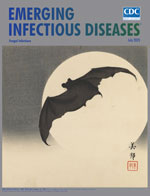
We retrospectively reviewed consecutive cases of mucormycosis reported from a tertiary-care center in India to determine the clinical and mycologic characteristics of emerging Rhizopus homothallicus fungus. The objectives were ascertaining the proportion of R. homothallicus infection and the 30-day mortality rate in rhino-orbital mucormycosis attributable to R. homothallicus compared with R. arrhizus. R. homothallicus accounted for 43 (6.8%) of the 631 cases of mucormycosis. R. homothallicus infection was independently associated with better survival (odds ratio [OR] 0.08 [95% CI 0.02–0.36]; p = 0.001) than for R. arrhizus infection (4/41 [9.8%] vs. 104/266 [39.1%]) after adjusting for age, intracranial involvement, and surgery. We also performed antifungal-susceptibility testing, which indicated a low range of MICs for R. homothallicus against the commonly used antifungals (amphotericin B [0.03–16], itraconazole [0.03–16], posaconazole [0.03–8], and isavuconazole [0.03–16]). 18S gene sequencing and amplified length polymorphism analysis revealed distinct clustering of R. homothallicus.
| EID | Rudramurthy SM, Singh S, Kanaujia R, Chaudhary H, Muthu V, Panda N, et al. Clinical and Mycologic Characteristics of Emerging Mucormycosis Agent Rhizopus homothallicus. Emerg Infect Dis. 2023;29(7):1313-1322. https://doi.org/10.3201/eid2907.221491 |
|---|---|
| AMA | Rudramurthy SM, Singh S, Kanaujia R, et al. Clinical and Mycologic Characteristics of Emerging Mucormycosis Agent Rhizopus homothallicus. Emerging Infectious Diseases. 2023;29(7):1313-1322. doi:10.3201/eid2907.221491. |
| APA | Rudramurthy, S. M., Singh, S., Kanaujia, R., Chaudhary, H., Muthu, V., Panda, N....Chakrabarti, A. (2023). Clinical and Mycologic Characteristics of Emerging Mucormycosis Agent Rhizopus homothallicus. Emerging Infectious Diseases, 29(7), 1313-1322. https://doi.org/10.3201/eid2907.221491. |
Zoonotic outbreaks of sporotrichosis are increasing in Brazil. We examined and described the emergence of cat-transmitted sporotrichosis (CTS) caused by the fungal pathogen Sporothrix brasiliensis. We calculated incidence and mapped geographic distribution of cases in Curitiba, Brazil, by reviewing medical records from 216 sporotrichosis cases diagnosed during 2011–May 2022. Proven sporotrichosis was established in 84 (39%) patients and probable sporotrichosis in 132 (61%). Incidence increased from 0.3 cases/100,000 outpatient visit-years in 2011 to 21.4 cases/100,000 outpatient visit-years in 2021; of the 216 cases, 58% (n = 126) were diagnosed during 2019–2021. The main clinical form of sporotrichosis was lymphocutaneous (63%), followed by localized cutaneous (24%), ocular (10%), multisite infections (3%), and cutaneous disseminated (<0.5%). Since the first report of CTS in Curitiba in 2011, sporotrichosis has increased substantially, indicating continuous disease transmission. Clinician and public awareness of CTS and efforts to prevent transmission are needed.
| EID | Cognialli R, Cáceres DH, Bastos F, Cavassin FB, Lustosa B, Vicente VA, et al. Rising Incidence of Sporothrix brasiliensis Infections, Curitiba, Brazil, 2011–2022. Emerg Infect Dis. 2023;29(7):1330-1339. https://doi.org/10.3201/eid2907.230155 |
|---|---|
| AMA | Cognialli R, Cáceres DH, Bastos F, et al. Rising Incidence of Sporothrix brasiliensis Infections, Curitiba, Brazil, 2011–2022. Emerging Infectious Diseases. 2023;29(7):1330-1339. doi:10.3201/eid2907.230155. |
| APA | Cognialli, R., Cáceres, D. H., Bastos, F., Cavassin, F. B., Lustosa, B., Vicente, V. A....Queiroz-Telles, F. (2023). Rising Incidence of Sporothrix brasiliensis Infections, Curitiba, Brazil, 2011–2022. Emerging Infectious Diseases, 29(7), 1330-1339. https://doi.org/10.3201/eid2907.230155. |
Volume 29, Number 6—June 2023
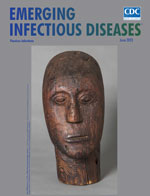
Tularemia is a zoonotic infection caused by Francisella tularensis. Its most typical manifestations in humans are ulceroglandular and glandular; infections in prosthetic joints are rare. We report 3 cases of F. tularensis subspecies holarctica–related prosthetic joint infection that occurred in France during 2016–2019. We also reviewed relevant literature and found only 5 other cases of Francisella-related prosthetic joint infections worldwide, which we summarized. Among those 8 patients, clinical symptoms appeared 7 days to 19 years after the joint placement and were nonspecific to tularemia. Although positive cultures are typically obtained in only 10% of tularemia cases, strains grew in all 8 of the patients. F. tularensis was initially identified in 2 patients by matrix-assisted laser desorption/ionization time-of-flight mass spectrometry; molecular methods were used for 6 patients. Surgical treatment in conjunction with long-term antimicrobial treatment resulted in favorable outcomes; no relapses were seen after 6 months of follow-up.
| EID | Ponderand L, Guimard T, Lazaro E, Dupuy H, Peuchant O, Roch N, et al. Case Studies and Literature Review of Francisella tularensis–Related Prosthetic Joint Infection. Emerg Infect Dis. 2023;29(6):1117-1126. https://doi.org/10.3201/eid2906.221395 |
|---|---|
| AMA | Ponderand L, Guimard T, Lazaro E, et al. Case Studies and Literature Review of Francisella tularensis–Related Prosthetic Joint Infection. Emerging Infectious Diseases. 2023;29(6):1117-1126. doi:10.3201/eid2906.221395. |
| APA | Ponderand, L., Guimard, T., Lazaro, E., Dupuy, H., Peuchant, O., Roch, N....Caspar, Y. (2023). Case Studies and Literature Review of Francisella tularensis–Related Prosthetic Joint Infection. Emerging Infectious Diseases, 29(6), 1117-1126. https://doi.org/10.3201/eid2906.221395. |
Babesiosis is a globally distributed parasitic infection caused by intraerythrocytic protozoa. The full spectrum of neurologic symptoms, the underlying neuropathophysiology, and neurologic risk factors are poorly understood. Our study sought to describe the type and frequency of neurologic complications of babesiosis in a group of hospitalized patients and assess risk factors that might predispose patients to neurologic complications. We reviewed medical records of adult patients who were admitted to Yale-New Haven Hospital, New Haven, Connecticut, USA, during January 2011–October 2021 with laboratory-confirmed babesiosis. More than half of the 163 patients experienced >1 neurologic symptoms during their hospital admissions. The most frequent symptoms were headache, confusion/delirium, and impaired consciousness. Neurologic symptoms were associated with high-grade parasitemia, renal failure, and history of diabetes mellitus. Clinicians working in endemic areas should recognize the range of symptoms associated with babesiosis, including neurologic.
| EID | Locke S, O’Bryan J, Zubair AS, Rethana M, Moffarah A, Krause PJ, et al. Neurologic Complications of Babesiosis, United States, 2011–2021. Emerg Infect Dis. 2023;29(6):1128-1135. https://doi.org/10.3201/eid2906.221890 |
|---|---|
| AMA | Locke S, O’Bryan J, Zubair AS, et al. Neurologic Complications of Babesiosis, United States, 2011–2021. Emerging Infectious Diseases. 2023;29(6):1128-1135. doi:10.3201/eid2906.221890. |
| APA | Locke, S., O’Bryan, J., Zubair, A. S., Rethana, M., Moffarah, A., Krause, P. J....Farhadian, S. F. (2023). Neurologic Complications of Babesiosis, United States, 2011–2021. Emerging Infectious Diseases, 29(6), 1128-1135. https://doi.org/10.3201/eid2906.221890. |
Volume 29, Number 5—May 2023
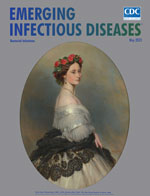
Recurrent Clostridioides difficile infection (RCDI) causes an increased burden on the healthcare system. We calculated RCDI incidence and identified factors associated with RCDI cases in New Haven County, Connecticut, USA, during 2015–2020 by using data from population-based laboratory surveillance. A subset of C. difficile cases had complete chart reviews conducted for RCDI and potentially associated variables. RCDI was defined as a positive C. difficile specimen occurring 2–8 weeks after incident C. difficile infection. We compared cases with and without RCDI by using multiple regression. RCDI occurred in 12.0% of 4,301 chart-reviewed C. difficile cases, showing a U-shaped time trend with a sharp increase in 2020, mostly because of an increase in hospital-onset cases. Malignancy (odds ratio 1.51 [95% CI 1.11–2.07]) and antecedent nitrofurantoin use (odds ratio 2.37 [95% CI 1.23–4.58]) were medical risk factors for RCDI. The 2020 increase may reflect the impact of the COVID-19 pandemic.
| EID | Okafor CM, Clogher P, Olson D, Niccolai L, Hadler J. Trends in and Risk Factors for Recurrent Clostridioides difficile Infection, New Haven County, Connecticut, USA, 2015–2020. Emerg Infect Dis. 2023;29(5):877-887. https://doi.org/10.3201/eid2905.221294 |
|---|---|
| AMA | Okafor CM, Clogher P, Olson D, et al. Trends in and Risk Factors for Recurrent Clostridioides difficile Infection, New Haven County, Connecticut, USA, 2015–2020. Emerging Infectious Diseases. 2023;29(5):877-887. doi:10.3201/eid2905.221294. |
| APA | Okafor, C. M., Clogher, P., Olson, D., Niccolai, L., & Hadler, J. (2023). Trends in and Risk Factors for Recurrent Clostridioides difficile Infection, New Haven County, Connecticut, USA, 2015–2020. Emerging Infectious Diseases, 29(5), 877-887. https://doi.org/10.3201/eid2905.221294. |
Clindamycin and β-lactam antibiotics have been mainstays for treating invasive group A Streptococcus (iGAS) infection, yet such regimens might be limited for strains displaying MLSB phenotypes. We investigated 76 iGAS isolates from 66 patients in West Virginia, USA, during 2020–2021. We performed emm typing using Centers for Disease Control and Prevention guidelines and assessed resistance both genotypically and phenotypically. Median patient age was 42 (range 23–86) years. We found 76% of isolates were simultaneously resistant to erythromycin and clindamycin, including all emm92 and emm11 isolates. Macrolide resistance was conferred by the plasmid-borne ermT gene in all emm92 isolates and by chromosomally encoded ermA, ermB, and a single mefA in other emm types. Macrolide-resistant iGAS isolates were typically resistant to tetracycline and aminoglycosides. Vulnerability to infection was associated with socioeconomic status. Our results show a predominance of macrolide-resistant isolates and a shift in emm type distribution compared with historical reports.
| EID | Powell LM, Choi S, Chipman CE, Grund ME, LaSala P, Lukomski S. Emergence of Erythromycin-Resistant Invasive Group A Streptococcus, West Virginia, USA, 2020–2021. Emerg Infect Dis. 2023;29(5):897-907. https://doi.org/10.3201/eid2905.221421 |
|---|---|
| AMA | Powell LM, Choi S, Chipman CE, et al. Emergence of Erythromycin-Resistant Invasive Group A Streptococcus, West Virginia, USA, 2020–2021. Emerging Infectious Diseases. 2023;29(5):897-907. doi:10.3201/eid2905.221421. |
| APA | Powell, L. M., Choi, S., Chipman, C. E., Grund, M. E., LaSala, P., & Lukomski, S. (2023). Emergence of Erythromycin-Resistant Invasive Group A Streptococcus, West Virginia, USA, 2020–2021. Emerging Infectious Diseases, 29(5), 897-907. https://doi.org/10.3201/eid2905.221421. |
Volume 29, Number 4—April 2023
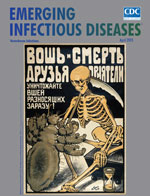
New Zealand (Aotearoa) experienced a Neisseria meningitidis serogroup B epidemic during 1991–2006, and incidence remains twice that of other high-income countries. We reviewed clinical, laboratory, and immunization data for children <15 years of age with laboratory-confirmed invasive meningococcal disease in Auckland, New Zealand, during January 1, 2004–December 31, 2020. Of 319 cases in 318 children, 4.1% died, and 23.6% with follow-up data experienced sequelae. Children of Māori and Pacific ethnicity and those living in the most deprived areas were overrepresented. Eighty-one percent were positive for N. meningitidis serogroup B, 8.6% for serogroup W, 6.3% for serogroup C, and 3.7% for serogroup Y. Seventy-nine percent had bacteremia, and 63.9% had meningitis. In New Zealand, Māori and Pacific children are disproportionately affected by this preventable disease. N. meningitidis serogroup B vaccine should be included in the New Zealand National Immunization Schedule to address this persistent health inequity.
| EID | Burton C, Best E, Broom M, Heffernan H, Briggs S, Webb R. Pediatric Invasive Meningococcal Disease, Auckland, New Zealand (Aotearoa), 2004–2020. Emerg Infect Dis. 2023;29(4):686-695. https://doi.org/10.3201/eid2904.221397 |
|---|---|
| AMA | Burton C, Best E, Broom M, et al. Pediatric Invasive Meningococcal Disease, Auckland, New Zealand (Aotearoa), 2004–2020. Emerging Infectious Diseases. 2023;29(4):686-695. doi:10.3201/eid2904.221397. |
| APA | Burton, C., Best, E., Broom, M., Heffernan, H., Briggs, S., & Webb, R. (2023). Pediatric Invasive Meningococcal Disease, Auckland, New Zealand (Aotearoa), 2004–2020. Emerging Infectious Diseases, 29(4), 686-695. https://doi.org/10.3201/eid2904.221397. |
During the SARS-CoV-2 pandemic, few cases of Nocardia spp. co-infection have been reported during or after a COVID-19 infection. Nocardia spp. are gram-positive aerobic actinomycetes that stain partially acid-fast, can infect immunocompromised patients, and may cause disseminated disease. We report the case of a 52-year-old immunocompromised man who had Nocardia pseudobrasiliensis pneumonia develop after a SARS-CoV-2 infection. We also summarize the literature for nocardiosis and SARS-CoV-2 co-infections. Nocardia spp. infection should remain a part of the differential diagnosis for pneumonia in immunocompromised hosts, regardless of other co-infections. Sulfonamide/carbapenem combinations are used as empiric therapy for nocardiosis; species identification and susceptibility testing are required to select the optimal treatment for each patient.
| EID | Stamos D, Barajas-Ochoa A, Raybould JE. Nocardia pseudobrasiliensis Co-infection in SARS-CoV-2 Patients. Emerg Infect Dis. 2023;29(4):696-700. https://doi.org/10.3201/eid2904.221439 |
|---|---|
| AMA | Stamos D, Barajas-Ochoa A, Raybould JE. Nocardia pseudobrasiliensis Co-infection in SARS-CoV-2 Patients. Emerging Infectious Diseases. 2023;29(4):696-700. doi:10.3201/eid2904.221439. |
| APA | Stamos, D., Barajas-Ochoa, A., & Raybould, J. E. (2023). Nocardia pseudobrasiliensis Co-infection in SARS-CoV-2 Patients. Emerging Infectious Diseases, 29(4), 696-700. https://doi.org/10.3201/eid2904.221439. |
Volume 29, Number 3—March 2023
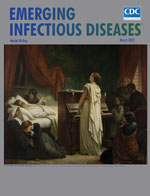
Molecular methods can enable rapid identification of Bartonella spp. infections, which are difficult to diagnose by using culture or serology. We analyzed clinical test results of PCR that targeted bacterial 16S rRNA hypervariable V1–V2 regions only or in parallel with PCR of Bartonella-specific ribC gene. We identified 430 clinical specimens infected with Bartonella spp. from 420 patients in the United States. Median patient age was 37 (range 1–79) years; 62% were male. We identified B. henselae in 77%, B. quintana in 13%, B. clarridgeiae in 1%, B. vinsonii in 1%, and B. washoensis in 1% of specimens. B. quintana was detected in 83% of cardiac specimens; B. henselae was detected in 34% of lymph node specimens. We detected novel or uncommon Bartonella spp. in 9 patients. Molecular diagnostic testing can identify Bartonella spp. infections, including uncommon and undescribed species, and might be particularly useful for patients who have culture-negative endocarditis or lymphadenitis.
| EID | McCormick DW, Rassoulian-Barrett SL, Hoogestraat DR, Salipante SJ, SenGupta D, Dietrich EA, et al. Bartonella spp. Infections Identified by Molecular Methods, United States. Emerg Infect Dis. 2023;29(3):467-476. https://doi.org/10.3201/eid2903.221223 |
|---|---|
| AMA | McCormick DW, Rassoulian-Barrett SL, Hoogestraat DR, et al. Bartonella spp. Infections Identified by Molecular Methods, United States. Emerging Infectious Diseases. 2023;29(3):467-476. doi:10.3201/eid2903.221223. |
| APA | McCormick, D. W., Rassoulian-Barrett, S. L., Hoogestraat, D. R., Salipante, S. J., SenGupta, D., Dietrich, E. A....Lieberman, J. A. (2023). Bartonella spp. Infections Identified by Molecular Methods, United States. Emerging Infectious Diseases, 29(3), 467-476. https://doi.org/10.3201/eid2903.221223. |
Incidence of Streptococcus dysgalactiae subspecies equisimilis (SDSE) bacteremia is increasing in the Kyoto-Shiga region of Japan. We retrospectively analyzed clinical features of SDSE bacteremia and conducted comparative genomic analyses of isolates collected from 146 bacteremia episodes among 133 patients during 2005–2021. Of those patients, 7.7% required vasopressor support, and 7.0% died while in the hospital. The prevalence of isolates resistant to erythromycin, minocycline, and clindamycin increased from 8.6% during 2005–2017 to 21.6% during 2018–2021. Our genomic analysis demonstrated that sequence type 525 and clonal complex 25 were predominant in SDSE isolates collected during 2018–2021. In addition, those isolates had acquired 2 antimicrobial-resistance genes, ermB and tetM, via Tn916-like integrative and conjugative elements (ICEs). Phylogenetic analysis revealed clonal distribution of Tn916-like ICEs in SDSE isolates. Our findings suggest that Tn916-like ICEs contributed to the emergence and recent increase of multidrug-resistant SDSE bacteremia in this region of Japan.
| EID | Shinohara K, Murase K, Tsuchido Y, Noguchi T, Yukawa S, Yamamoto M, et al. Clonal Expansion of Multidrug-Resistant Streptococcus dysgalactiae Subspecies equisimilis Causing Bacteremia, Japan, 2005–2021. Emerg Infect Dis. 2023;29(3):528-539. https://doi.org/10.3201/eid2903.221060 |
|---|---|
| AMA | Shinohara K, Murase K, Tsuchido Y, et al. Clonal Expansion of Multidrug-Resistant Streptococcus dysgalactiae Subspecies equisimilis Causing Bacteremia, Japan, 2005–2021. Emerging Infectious Diseases. 2023;29(3):528-539. doi:10.3201/eid2903.221060. |
| APA | Shinohara, K., Murase, K., Tsuchido, Y., Noguchi, T., Yukawa, S., Yamamoto, M....Nagao, M. (2023). Clonal Expansion of Multidrug-Resistant Streptococcus dysgalactiae Subspecies equisimilis Causing Bacteremia, Japan, 2005–2021. Emerging Infectious Diseases, 29(3), 528-539. https://doi.org/10.3201/eid2903.221060. |
Volume 29, Number 2—February 2023
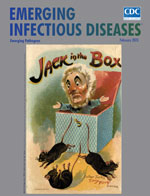
Infant botulism (IB) is an intestinal toxemia that manifests as descending paralysis, constipation, and, in some cases, respiratory failure. Laboratory-confirmed IB cases are rare, and recent data in Israel are lacking. We conducted a national multicenter retrospective study of laboratory-confirmed IB cases reported in Israel during 2007–2021. A total of 8 cases were reported during the study period. During 2019–2021, incidence may have increased because of a cluster of 5 cases. Infant median age for diagnosis was 6.5 months, older than previously reported (3 months). Most cases occurred during March–July. Honey consumption was reported in 1 case, and possible environmental risk factors (living nearby rural or construction areas, dust exposure, and having a father who works as a farmer) were reported in 6 cases. Although IB is rare, its incidence in Israel may have increased over recent years, and its epidemiology and risk factors differ from cases reported previously in Israel.
| EID | Goldberg B, Danino D, Levinsky Y, Levy I, Straussberg R, Dabaja-Younis H, et al. Infant Botulism, Israel, 2007–2021. Emerg Infect Dis. 2023;29(2):235-241. https://doi.org/10.3201/eid2902.220991 |
|---|---|
| AMA | Goldberg B, Danino D, Levinsky Y, et al. Infant Botulism, Israel, 2007–2021. Emerging Infectious Diseases. 2023;29(2):235-241. doi:10.3201/eid2902.220991. |
| APA | Goldberg, B., Danino, D., Levinsky, Y., Levy, I., Straussberg, R., Dabaja-Younis, H....Scheuerman, O. (2023). Infant Botulism, Israel, 2007–2021. Emerging Infectious Diseases, 29(2), 235-241. https://doi.org/10.3201/eid2902.220991. |
Crimean-Congo hemorrhagic fever (CCHF) is a viral infectious disease for which distribution of the main vector, Hyalomma spp. ticks, is expanding. We analyzed all 10 cases of CCHF diagnosed in Spain during 2013–2021; case-patient median age was 56.5 years, and 7 were men. We identified CCHF virus genotypes III and V. Six case-patients acquired the infection in urban areas. Sixty percent of patients were infected in summer and 40% in spring. Two patients met criteria for hemophagocytic syndrome. Seven patients survived. The epidemiologic pattern of CCHF in Spain is based on occasional cases with an elevated mortality rate. Genotype III and, to a less extent also genotype V, CCHF circulates in humans in a common geographic area in Spain. Those data suggest that the expansion pathways are complex and may change over time. Physicians should remain alert to the possibility of new CCHF cases.
| EID | Lorenzo Juanes H, Carbonell C, Sendra B, López-Bernus A, Bahamonde A, Orfao A, et al. Crimean-Congo Hemorrhagic Fever, Spain, 2013–2021. Emerg Infect Dis. 2023;29(2):252-259. https://doi.org/10.3201/eid2902.220677 |
|---|---|
| AMA | Lorenzo Juanes H, Carbonell C, Sendra B, et al. Crimean-Congo Hemorrhagic Fever, Spain, 2013–2021. Emerging Infectious Diseases. 2023;29(2):252-259. doi:10.3201/eid2902.220677. |
| APA | Lorenzo Juanes, H., Carbonell, C., Sendra, B., López-Bernus, A., Bahamonde, A., Orfao, A....Belhassen-García, M. (2023). Crimean-Congo Hemorrhagic Fever, Spain, 2013–2021. Emerging Infectious Diseases, 29(2), 252-259. https://doi.org/10.3201/eid2902.220677. |
Volume 29, Number 1—January 2023
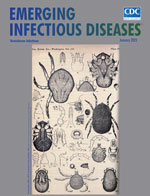
The emergence of SARS-CoV-2 and the worldwide COVID-19 pandemic triggered considerable attention to the emergence and evolution of novel human pathogens. Bourbon virus (BRBV) was first discovered in 2014 in Bourbon County, Kansas, USA. Since its initial discovery, several cases of BRBV infection in humans have been identified in Kansas, Oklahoma, and Missouri. BRBV is classified within the Thogotovirus genus; these negative-strand RNA viruses appear to be transmitted by ticks, and much of their biology remains unknown. In this review, we describe the emergence, virology, geographic range and ecology, and human disease caused by BRBV and discuss potential treatments for active BRBV infections. This virus and other emerging viral pathogens remain key public health concerns and require continued surveillance and study to mitigate human exposure and disease.
| EID | Roe MK, Huffman ER, Batista YS, Papadeas GG, Kastelitz SR, Restivo AM, et al. Comprehensive Review of Emergence and Virology of Tickborne Bourbon Virus in the United States. Emerg Infect Dis. 2023;29(1):1-7. https://doi.org/10.3201/eid2901.212295 |
|---|---|
| AMA | Roe MK, Huffman ER, Batista YS, et al. Comprehensive Review of Emergence and Virology of Tickborne Bourbon Virus in the United States. Emerging Infectious Diseases. 2023;29(1):1-7. doi:10.3201/eid2901.212295. |
| APA | Roe, M. K., Huffman, E. R., Batista, Y. S., Papadeas, G. G., Kastelitz, S. R., Restivo, A. M....Stobart, C. C. (2023). Comprehensive Review of Emergence and Virology of Tickborne Bourbon Virus in the United States. Emerging Infectious Diseases, 29(1), 1-7. https://doi.org/10.3201/eid2901.212295. |
We performed a case–control study across 25 hospitals in India for the period of January–June 2021 to evaluate the reasons for an COVID-19–associated mucormycosis (CAM) outbreak. We investigated whether COVID-19 treatment practices (glucocorticoids, zinc, tocilizumab, and others) were associated with CAM. We included 1,733 cases of CAM and 3,911 age-matched COVID-19 controls. We found cumulative glucocorticoid dose (odds ratio [OR] 1.006, 95% CI 1.004–1.007) and zinc supplementation (OR 2.76, 95% CI 2.24–3.40), along with elevated C-reactive protein (OR 1.004, 95% CI 1.002–1.006), host factors (renal transplantation [OR 7.58, 95% CI 3.31–17.40], diabetes mellitus [OR 6.72, 95% CI 5.45–8.28], diabetic ketoacidosis during COVID-19 [OR 4.41, 95% CI 2.03–9.60]), and rural residence (OR 2.88, 95% CI 2.12–3.79), significantly associated with CAM. Mortality rate at 12 weeks was 32.2% (473/1,471). We emphasize the judicious use of COVID-19 therapies and optimal glycemic control to prevent CAM.
| EID | Muthu V, Agarwal R, Rudramurthy S, Thangaraju D, Shevkani M, Patel AK, et al. Multicenter Case–Control Study of COVID-19–Associated Mucormycosis Outbreak, India. Emerg Infect Dis. 2023;29(1):8-19. https://doi.org/10.3201/eid2901.220926 |
|---|---|
| AMA | Muthu V, Agarwal R, Rudramurthy S, et al. Multicenter Case–Control Study of COVID-19–Associated Mucormycosis Outbreak, India. Emerging Infectious Diseases. 2023;29(1):8-19. doi:10.3201/eid2901.220926. |
| APA | Muthu, V., Agarwal, R., Rudramurthy, S., Thangaraju, D., Shevkani, M., Patel, A. K....Chakrabarti, A. (2023). Multicenter Case–Control Study of COVID-19–Associated Mucormycosis Outbreak, India. Emerging Infectious Diseases, 29(1), 8-19. https://doi.org/10.3201/eid2901.220926. |
CME Articles by Volume

